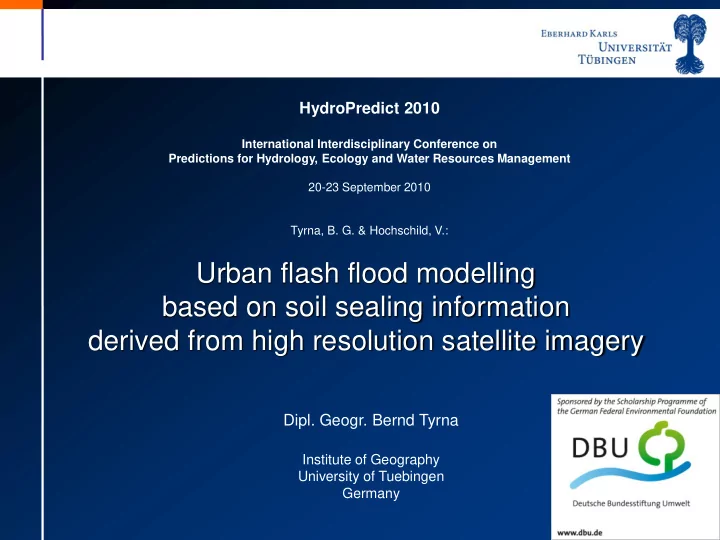

HydroPredict 2010 International Interdisciplinary Conference on Predictions for Hydrology, Ecology and Water Resources Management 20-23 September 2010 Tyrna, B. G. & Hochschild, V.: Urban flash flood modelling based on soil sealing information derived from high resolution satellite imagery Dipl. Geogr. Bernd Tyrna Institute of Geography University of Tuebingen Germany
Heavy rainfall and flash flood events in Germany • Distribution of flash flood events URBAS event data base (1990-2007) • Sum of financial damages from flash flood events compareable to damage sum of large river floodings • Objective: hazard analysis of flash floods • Methodology: combine remotely sensed soil sealing information with hydrodynamic modelling of overland flow (1m spatial resolution) 1
Study area: City of Tübingen, Germany 2
Methodology Object-based image analysis of QuickBird satellite image land use map 1. soil sealing information 2. Soil sealing modelling using iSurf-A (Impervious Surface Analyst, developed at Uni Würzburg) 3. Calculation of excess rainfall using modified Curve Number method CCN = Composite CN CCN = CN i ∙ a + CN p ∙ (1 - a ) CN i = CN (impervious) = 98 CN p = CN (pervious) = 71 a = degree of surface sealing P = rainfall [mm] Q = excess rainfall [mm] 4. Modelling of overland flow using GRASS GIS module r.sim.water LiDAR DEM with 1m resolution and 0.15 m vertical accuracy 3
Remote sensing: soil sealing analysis for the city of Tuebingen, SW-Germany QuickBird satellite image (27 June 2007); resolution: 0,6m (panchromatic), 2,4m (multispectral) 4
Remote sensing: soil sealing analysis for the city of Tübingen, SW -Germany Degree of soil sealing: Calculation of runoff (effective rainfall): CCN = CN i ∙ a + CN p ∙ (1- a ) 0 (0% soil sealing = permeable) to 1 (100% soil sealing = impermeable) 5
Modelling of overland flow, Tübingen • Input: – LiDAR DEM 1m – Excess rainfall – Manning's n • Rainfall intensity: 30 mm/h • Output: – Flow depth after 60min • Red marks: inundated buildings at 2002 event 6
Conclusions and outlook • Basis for an analysis of urban flash flood hazard • High spatial resolution → analysis on the level of individual buildings • Advantages of the remote sensing approach: – Application in cities where cadastral data is not available – Change detection of soil sealing by time series analysis (how does increased soil sealing affect urban runoff?) • Future work: – Further validation of model results (DEM accuracy?) – Simulation of scenarios (rainfall intensity and durarion) – Method needed to account for losses in urban sewage system – Development of simplified sewage model and coupling with r.sim.water 7
End Thank you very much for your attention! Contact: Dipl.-Geogr. Bernd Tyrna University of Tuebingen Institute of Geography Prof. Dr. Volker Hochschild Rümelinstr. 19 -23 72070 Tübingen Email: bernd.tyrna@gmx.de 8
Methodology Object-based image analysis of QuickBird satellite image land use map 1. Soil sealing modelling using iSurf-A soil sealing information 2. (Impervious Surface Analyst, developed at Uni Würzburg) a) Model building on training area (subset) b) Model application (entire scene) Quickbird Quickbird Gesamtszene Subset Quickbird Gesamtszene Subset of land use map Quickbird scene scene Support reclassification Modelling of Vector iSurf-A (model) sealed/unsealed soil sealing Machine Karte mit Karte mit Versiegelungsgraden Binary soil sealing Map with soil Versiegelungsgraden sealing information training data 4
Recommend
More recommend